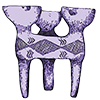‘Medical’ Childbirth versus ‘Natural’ Childbirth: Discussions about Cesarean Section in the Readers’ Comments
DOI:
https://doi.org/10.33831/jws.v17i2.212Keywords:
C-section, body, medicalization, control, natural, culturalAbstract
Both governments and public health organizations consider the ever-increasing rates of C-section, which is one of the tangible implementations of medicalization of reproductive systems of women, as a serious problem. Turkey has one of the world’s highest cesarean rates and the rapid increase of cesarean delivery has been a basis for justification of law amendment. The limitation of elective C-section, however, has led to controversy. In this paper readers’ comments to news about statements made by government officials that cesarean delivery without medical reason should be limited and discussions about this regulation are analyzed. By examining the readers’ comments, this study aims to reveal how commentators comprehend the medicalization of childbirth, how they signify medical interventions and establish dichotomies between normal and medical, natural and cultural. For this purpose, all comments published in the web site of Hürriyet newspaper, starting from 25 May 2012 to the end of the year, are analyzed.
References
Badinter E. (2011). Kadınlık mı? Annelik mi? (Çev.Ekmekçi A.). İstanbul: İletişim.
Bakan O Sözlerine Açıklama Getirdi (2012, 1 Haziran). Hürriyet.
Bakanlık Sezaryeni Kısıtlamak İstiyor Kadınlar Bizi Özgür Bırakın Diyor. (2006, 1 Ekim). Hürriyet.
Beck N.C., Geden E.A. & Brouder G.T. (1979). Preparation for Labor: A Historical Perspective. Psychosomatic Medicine, 41(3): 243-258.
Beckett K. (2005). Choosing Cesarean Feminism and the Politics of Childbirth in the United States. Feminist Theory, 6(3): 251-275.
Bora-Başara B., Güler C. & Yentür G.K. (2014). Sağlık Bakanlığı İstatistikleri Yıllığı 2013. Sağlık Araştırmaları Genel Müdürlüğü. Ankara: Sağlık Bakanlığı.
Brubaker S.J. & Dillaway H.E. (2009). Medicalization, Natural Childbirth and Birthing Experiences. Sociology Compass, 3(1): 31-48.
Cahill H.A. (2001). Male Appropriation and Medicalization Of Childbirth: An Historical Analysis. Journal of Advanced Nursing, 33(3): 334-342.
CIMS, Mother-Friendly Childbirth Initiative. İnternet adresi: http://www.mothe rfriendly.org/MFCI. Erişim tarihi: 27.7.2015.
Cindoğlu, D. & Sayan-Cengiz, F. (2010). Türkiye’de Doğumların Medikalizasyonu: Feminist Bir Bakışla Sezaryen Problemini Düşünmek, II. Hekimlik ve Kadın Sağlığı Kongresi Kitabı, Ankara, 51-64.
Conrad P. (1992). Medicalization and Social Control. Annual Review of Sociology, 18(1): 209-232.
Cosans C. (2004). The Meaning of Natural Childbirth. Perspectives in Biology and Medicine, 47(2): 266-272.
Crossley M.L. (2007). Childbirth, Complications and the İllusion of Choice: A Case Study. Feminism & Psychology, 17(4): 543-563.
Çevikel, T. (2013). Türkiye’deki İnternet Gazetelerinde Kullanıcı Katılımının İşleyişi ve Sınırlılıkları. İletişim Kuram ve Araştırma Dergisi, 37:1-21.
Davis-Floyd R.E. (1994). The Technocratic Body: American Childbirth as Cultural Expression. İnternet adresi: http://www.researchgate.net/profile/Robbie_ Davis-loyd/publication/15157296_The_technocratic_body_American_childbirth _as_cultural_expression/links/0fcfd511ea268b07f7000000.pdf. Erişim tarihi: 20.4.2015.
Demirgöz-Bal M., Dereli-Yılmaz S. & Kızılkaya-Beji N. (2013). Kadınların Sezaryen Doğum Tercihleri. Hemşirelik Dergisi, 21(2): 139-146.
Erdoğan: 3 Çocuğu Vatana Hibe Edin. (2013, 8 Ağustos). Radikal.
Erdoğan: CHP Kürt Meselesinin Kaynağı. (2012, 2 Haziran). Milliyet.
Federici, S. (2012). Caliban ve Cadı: Kadınlar, Beden ve İlksel Birikim. Öznur Karakaş (Çev.). İstanbul: Otonom.
Frost J., Pope C., Liebling R. & Murphy D. (2006). Utopian Theory And The Discourse of Natural Birth. Social Theory & Health, 4(4): 299-318.
Hacettepe Üniversitesi Nüfus Etütleri Enstitüsü (1999). 1998 Türkiye Nüfus ve Sağlık Araştırması (TNSA-1998).Ankara.
Hastanelerde Sezaryenle Doğum Oranı Yüzde 15’i Geçemeyecek. (2008, 14 Eylül). Milliyet.
Johanson R., Newburn M. & Macfarlane A. (2002). Has the Medicalisation of Childbirth Gone too Far? BMJ, 324(7342): 892-895.
Jones J.C. (2012). Idealized and Industrialized Labor: Anatomy of a Feminist Controversy. Hypatia, 27(1): 99-117.
Köse E. (2009). Bir Keşif Olarak Modern Kadınlık: Tıp, Beden Ve Cinsellik. Fe Dergi, 1(2): 71-78.
Kubilay Ç. (2014). İslami Muhafazakâr Kadın Yazarların Perspektifinden Kürtaj Tartışması: Eleştirel Bir Değerlendirme. Alternatif Politika, 6(3): 387-421.
Lothian J.A. (2007). Introduction: The Coalition for Improving Maternity Services. The Journal of Perinatal Education, 16(Suppl 1): 1S-4S.
Lupton D. (2012). Medicine as Culture: İllness, Disease and the Body. SAGE.
MacDorman M.F., Mathews, T.J. & Declercq E. (2012). Home Births in the United States, 1990–2009. Internet adresi: http://www.cdc.gov/nchs/data/da tabriefs/db84.pdf. Erişim tarihi: 5.5.2015.
Maternity Statistics–England. İnternet adresi: http://www.nct.org.uk/profession al/research/maternity%20statistics/maternity-statistics-england. Erişim tarihi: 10.5.2015.
Moscucci O. (2003). Holistic Obstetrics: the Origins of ‘Natural Childbirth’ in Britain. Postgraduate Medical Journal, 79(929): 168-173.
OECD (2012), Health Care Use-Caesarean Sections (total, Per 1000 live births, 2012), https://data.oecd.org/healthcare/caesarean-sections.htm (Erişim tarihi: 27 Temmuz 2015).
Onat- Bayram G. ( 2009). Kanıta Dayalı Uygulamalar Doğrultusunda Alternatif Bir Doğum Yöntemi: Evde Doğum. Maltepe Üniversitesi Hemşirelik Bilim ve Sanatı Dergisi, 2(3): 99-104.
Osterman M.J.K. & Martin J.A. (2013). Changes in Cesarean Delivery Rates by Gestational Age: United States, 1996–2011, No: 124. İnternet adresi: http://www.cdc.gov/nchs/data/databriefs/db124.htm#x2013;2011</a>. Erişim tarihi: 10.5.2015.
Riessman C.K. (1983). Women and Medicalization: A New Perspective. Social Policy, 14(1): 3-18.
Sezaryen Düzenlemesi Yasalaştı. (2012, 4 Temmuz). Bianet. http://bianet.org/ bianet/kadin/139508-sezaryen-duzenlemesi-yasalasti (Erişim tarihi: 10 Mayıs 2015).
Sezaryen İsteyenlerin Dertleri Money Money. (2012, 2 Haziran). Hürriyet.
Sezaryen Meclis’te. (2012, 21 Haziran). Milliyet.
Sezaryen Mi Normal Doğum Mu? (2012, 22 Haziran). Hürriyet.
Shaw J.C. (2013). The Medicalization of Birth and Midwifery as Resistance. Health Care for Women International, 34(6): 522-536.
Şenol-Cantek F. (2007). Okurunun gazetesi/Gazetesinin okuru: Hürriyet gazetesinin yorum sayfası üzerine. Toplum ve Bilim, 109-110: 66-96.
Tournaire M. & Theau-Yonneau A. (2007). Complementary and alternative approaches to pain relief during labor. Evidence-Based Complementary And Alternative Medicine, 4(4), 409-417.
Turner B. (2011). Tıbbi Güç ve Toplumsal Bilgi. (Çev.Ümit Tatlıcan). İstanbul: Sentez.
WHO Global Health Observatory Data Repository, Data by WHO Region. İnternet adresi: http://apps.who.int/gho/data/view.main.1610?lang=en. Erişim tarihi: 27. 7. 2015.
WHO (2015). WHO Statement on Caesarean Section Rates. İnternet adresi: http://apps.who.int/iris/bitstream/10665/161442/1/WHO_RHR_15.02_eng.pdf?ua=1. Erişim tarihi: 27.7.2015.
WHO (2014). Maternal Mortality. Fact Sheet N°348. İnternet adresi: http://www.who.int/mediacentre/factsheets/fs348/en/. Erişim tarihi: 10. 5. 2015.
Yeğenoğlu M. & Coşar S. (2014). AKP ve Toplumsal Cinsiyet Meselesi: Neoliberalizm ve Patriyarka Arasında Mekik Dokumak. İçinde Coşar S. & Yücesan-Özdemir G. (Eds.), İktidarın Şiddeti, AKP’li Yıllar, Neoliberalizm ve İslamcı Politikalar. İstanbul: Metis: 158-181.
Young I.M. (2005). On Female Body Experience: ‘Throwing like a girl’ and Other Essays. Oxford University Press.
Zadoroznyj M. (1999). Social class, social selves and social control in childbirth. Sociology of Health & Illness, 21(3): 267-289.
Downloads
Published
Issue
Section
License
Authors who publish with this journal agree to the following terms:
- Authors retain copyright and grant the journal right of first publication, with the work [6 months] after publication simultaneously licensed under a Creative Commons Attribution License that allows others to share the work with an acknowledgement of the work's authorship and initial publication in this journal.
- Authors are able to enter into separate, additional contractual arrangements for the non-exclusive distribution of the journal's published version of the work (e.g., post it to an institutional repository or publish it in a book), with an acknowledgement of its initial publication in this journal.
- Authors are permitted and encouraged to post their work online (e.g., in institutional repositories or on their website) prior to and during the submission process, as it can lead to productive exchanges, as well as earlier and greater citation of published work (See The Effect of Open Access)







